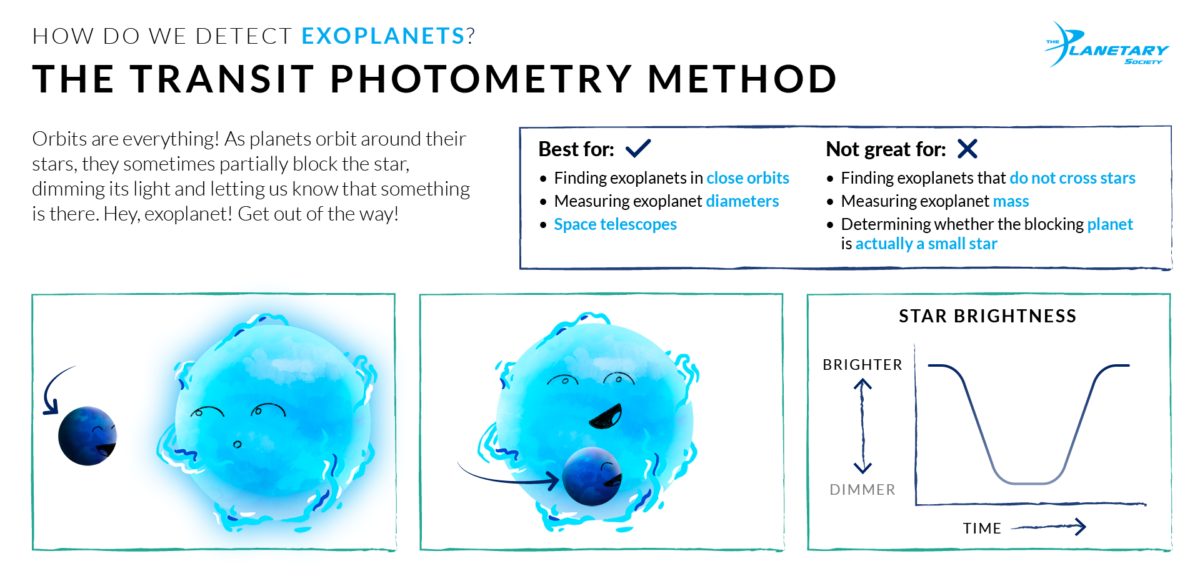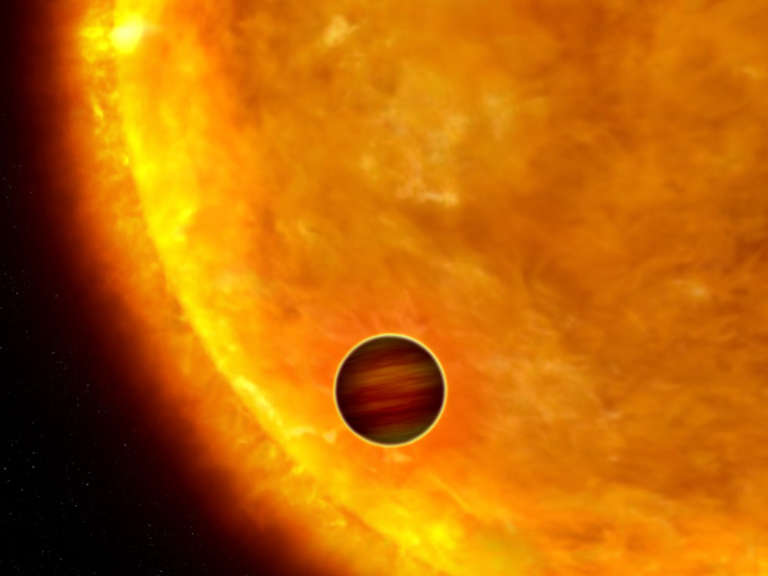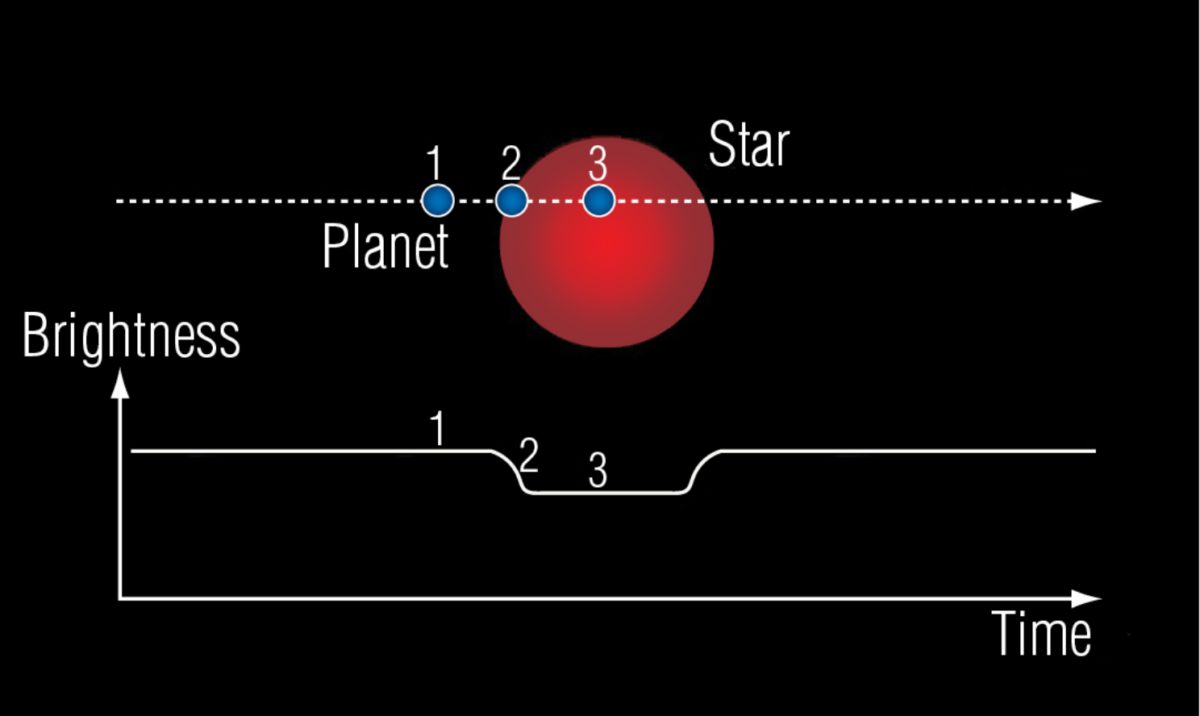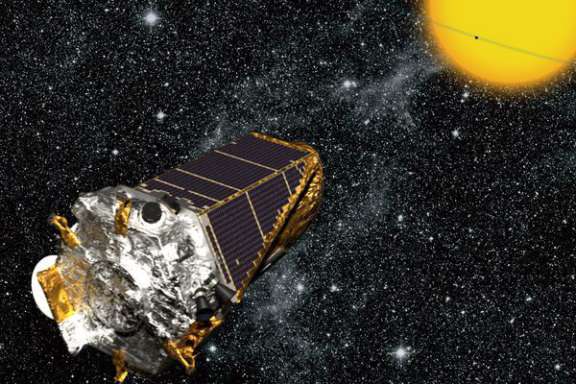Down in Front!: The Transit Photometry Method
Planets may give themselves away when they pass in front of a star and dim some of its light. The passage of a planet between a star and Earth is called a "transit." If such a dimming is detected at regular intervals and lasts a fixed, repeated length of time, then it is very likely that another, dimmer object is orbiting the star. Some of these transiting objects might be small, dim stars (in which case the pair is called an eclipsing binary), but most of them are planets.

How much a star dims during a transit directly relates to the relative sizes of the star and the planet. A small planet transiting a large star will create only a slight dimming, while a large planet transiting a small star will have a more noticeable effect. The size of the host star can be known with considerable accuracy from its spectrum, and photometry therefore gives astronomers a good estimate of the orbiting planet's diameter, but not its mass. This makes photometry an excellent complement to the radial-velocity method, which allows an estimate (a lower limit) of a planet's mass, but provides no information on the planet's diameter. Using both methods, combining mass and diameter, scientists can calculate the planet's density. Density, in turn, can suggest whether a planet is rocky, gassy, or in between.

Advantages
Transit photometry is currently the most effective and sensitive method for detecting extrasolar planets. It is a particularly advantageous method for space-based observatories that can stare continuously at stars for weeks or months. It also can be performed from the ground with quite small telescopes; the TRAPPIST telescopes only have 60-centimeter primary mirrors.
Transits provide scientists with estimates of planet diameters, a physical property not otherwise measurable. Because transiting exoplanets orbit in orbital planes that are necessarily edge-on to Earth-based observers, using both the transit method and the radial-velocity method to observe the same planet can provide the planet's mass and therefore its density and likely composition. Transits can provide scientists with a great deal of infFirst and foremost the "dip" in a star's luminosity during transit is directly propotionate to the size of the planet. Since the star's size is known known with a high degree of accuracy, the planet's size can be deduced from the degree to which it dims during transit.
If the transiting planet has an atmosphere, some of the light from the star passes through the planet's atmosphere on its way to Earth. Some wavelengths of that starlight are preferentially blocked by gases in the atmosphere. By studying the spectrum of a star both during a transit and outside a transit, astronomers can find telltale dips in the spectrum of starlight that are diagnostic of the presence of atmospheric gases. Water vapor is one molecule that can be observed using transit spectroscopy.
In addition to "primary" transits, which occur when a planet passes in front of its star, scientists are also interested in "secondary" transits, which occur when a planet completely disappears behind the star as seen from Earth. By deducting the star's light spectrum when the planet is hidden from the spectrum when it is visible, scientists can arrive at the planet's spectrum (that is, its color). The color of the light emitted by a planet is a clue to its temperature and can also hint at the composition of its atmosphere.
Finally, transit photometry searches can operate on a massive scale. Transit surveys (both ground- and space-based) can simultaneously watch as many as 100,000 stars at a time.

Disadvantages
The main difficulty with the transit-photometry method is that in order for the photometric effect to be measured, a transit must occur. Not all planets orbiting other stars transit their stars as seen from Earth; a distant planet must pass directly between its star and Earth. Unfortunately, for most extrasolar planets this simply never happens. In order for a transit to occur the orbital plane must be almost exactly edge-on to the observer, and this is true only of a small minority of distant planets. The rest will never be detected with photometry.
Another problem is that a planet's transit lasts only a tiny fraction of its total orbital period. A planet might take months or years to complete its orbit, but the transit would probably last only hours or days. As a result, even when astronomers observe a star with a transiting planet, they are extremely unlikely to observe a transit in progress. The problem is further compounded because in order to establish the presence of a planet, astronomers need to observe not only one, but many transits occurring at regular intervals. Therefore, the transit photometry method is heavily biased toward the discovery of short-period planets (ones that orbit quite close to their stars). Many such short-period planets are in the habitable zones of their host stars because the host stars are very dim, so it is possible to discover habitable planets orbiting other stars with the transit photometry method.
The transit photometry method tends to produce false positives, because the smallest stars can have diameters that are similar to those of giant planets. Therefore, objects that transit stars are considered only candidate planets until further measurements confirm that their diameters and/or masses are small enough for them to be considered planets.

Search Strategies
In order to have a good chance of observing transiting planets at the moment of transit, searches must continuously cover vast stretches of sky containing many stars for long periods of time. Transit-photometry searches are conducted by automated telescopes that stare at stars for as long as possible (hours at a time for ground-based telescopes and months for space-based telescopes).
The Kepler mission used photometry to search for extrasolar planets from space, producing thousands of discoveries from 2009 to the mission's end in 2019; more discoveries will follow as candidate planets are confirmed. Kepler followed CoRoT (Convection Rotation and Planetary Transits), which was a joint space mission of the French Space Agency (CNES) and the European Space Agency (ESA) that operated from 2006 to 2013, producing 32 exoplanet discoveries.
Kepler and CoRoT were succeeded by the Transiting Exoplanet Survey Satellite (TESS), which has been surveying for new planets since 2018, and the Characterising Exoplanet Satellite (CHEOPS), which launched in December 2019 to perform follow-up observations of transiting exoplanets to measure atmospheric composition.
Many ground-based observatories survey the skies for transiting exoplanets, including the 2 telescopes of TRAPPIST, the 7 telescopes of HATNet, the 2 telescopes of the MEarth project, and the forthcoming 4-telescope SPECULOOS survey.
While the discovery of a new planet with photometry requires the most advanced professional equipment (or an inordinate amount of luck), observing the transit of a known planet is much easier. This is because if one knows where to look and when, the effect of the transit itself can be quite substantial and easily detectable even with a relatively small telescope. In May 2001, for example, thousands of amateur astronomers around the world turned their telescopes towards a nearby red dwarf known as Gliese 876. This star was known to be orbited by two planets, both of which were discovered using the radial-velocity method. Since the star is small, and the planets orbiting it are large, the transit of the larger of the two dimmed the star substantially. This made it possible for amateurs the world over to observe the telltale signs of the presence of an extrasolar planet. The Exoplanet Section of the American Association of Variable Star Observers (AAVSO) coordinates amateur-astronomer participation in exoplanet transit observations.
This page was originally written in 2002 by staff writers for The Planetary Society. The Society most recently revised and updated it in February 2020 and thanks Emily Sandford for helpful comments.
How to Search for Exoplanets
Some methods almost sound like science fiction: Using gravity as a magnifying glass, watching stars wobble at turtle-like speeds, and searching for tiny dips in starlight.


 Explore Worlds
Explore Worlds Find Life
Find Life Defend Earth
Defend Earth


